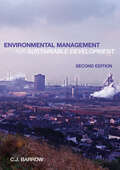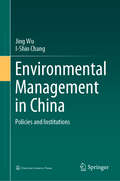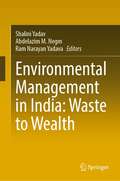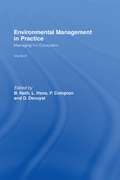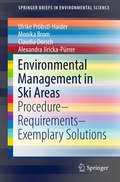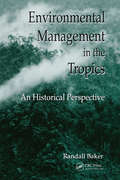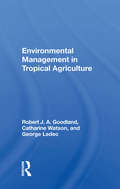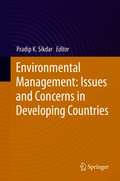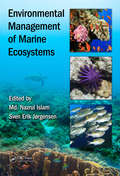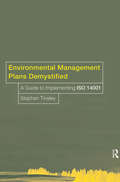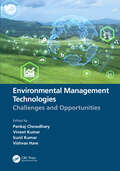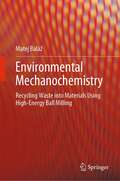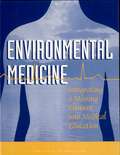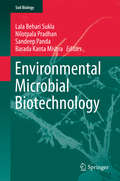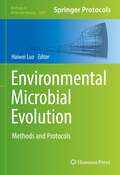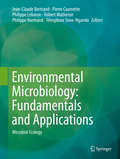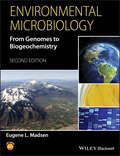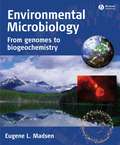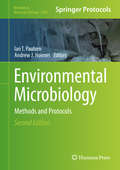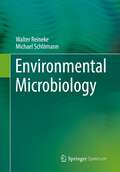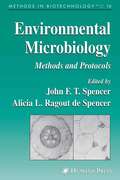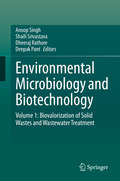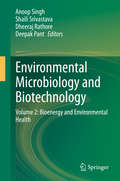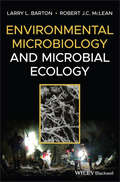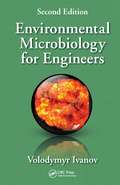- Table View
- List View
Environmental Management for Sustainable Development
by Chris BarrowEnvironmental management is a wide, expanding, and rapidly evolving field, affecting everyone from individual citizens to businesses; governments to international agencies. Indisputably, it plays a crucial role in the quest for sustainable development. This comprehensively updated second edition explores the nature and role of environmental management, covering key principles, practices, tools, strategies and policies, offers a thorough yet understandable introduction, and points to further in-depth coverage. Among the key themes covered are: sustainable development proactive approaches the precautionary principle the ‘polluter pays’ principle the need for humans to be less vulnerable and more adaptable. Reflecting the expansion and evolution of the field, this revised edition focuses strongly on sustainable development. There has been extensive restructuring to ensure the book is accessible to those unfamiliar with environmental management and it now includes greater coverage of topics including key resources under stress, environmental management tools, climate change and urban environmental management. With rapid expansion and development of the subject it is easy for those embarking on a course of study to become disorientated, but with its well-structured coverage, effective illustrations, and foundation for further, more-focused interest, this book is easily accessible to all.
Environmental Management in China: Policies and Institutions
by Jing Wu I-Shin ChangThis book details various stages in the introduction, establishment and evolution of China’s environmental management system. By combining a literature review, comparative analysis, and case study, it investigates the environmental management system in several key periods in order to systematically assess the necessary measures and appropriate adjustments the Chinese Government implemented to reconcile the growing conflicts between economic development and resources conservation, in the context of rapid economic growth and economic transformation. Given its scope, the book offers a valuable resource for experts, scholars, and government officials in related fields.
Environmental Management in India: Waste to Wealth
by Shalini Yadav Abdelazim M. Negm Ram Narayan YadavaThis book presents unique connectivity between waste management within the agenda 2030 of India. This book is the first publication presenting up-to-date work and knowledge about waste management and waste technologies to transfer waste to wealth in India. Besides, this book also presents the role of waste management and its contribution to achieving a sustainable development program in India, with vast implication worldwide. The main focuses of the book include waste and wealth and the associated technologies, recycling of solid waste, utilization of hazardous waste, use of nanoparticle in waste management, urban solid waste, generation of energy from organic waste, clean technologies, and use of waste in agriculture. The book is a unique source of information on the transformation of waste to wealth in India. This book is of interest to research communities in the field of waste management in India, and in similar socioeconomic countries, but also, due to the planetary implications, has global interest.
Environmental Management in Practice: Managing the Ecosystem
by B. Nath L. Hens P. Compton D. DevuystVolume 3: Managing the Ecosystem focuses on those ecosystems in which human intervention has been or continues to be predominant, specifically within cities and rural areas.
Environmental Management in Ski Areas: Procedure - Requirements - Exemplary Solutions (SpringerBriefs in Environmental Science)
by Alexandra Jiricka-Pürrer Claudia Dorsch Monika Brom Ulrike Pröbstl-HaiderThis book raises awareness of environmentally friendly and resource-sparing management of winter sports areas, in order to increase the number of certified ski areas. Many ski areas today are advertised with seals of approval, titles and awards. Often, however, it is unclear which institutions and criteria are behind these appraisals. This practice is widely criticized as “green-washing”, since a cautious use of ecologically and scenically sensitive mountain areas is more important now than ever. An environmental management system based on international or European standards ensures “real” improvements and external evaluation, but relies on the personal responsibility of the providers rather than on regulations imposed by authorities. This book contributes to developing a trustworthy and unified system for such evaluation, and one that can be applied internationally.
Environmental Management in the Tropics: An Historical Perspective
by Randall BakerThe arrival of western science and economic interests to the tropics has dramatically changed the tropical environment and its ecology. Environmental Management in the Tropics discusses the ecology of the tropics and examines how it is different from the temperate zone where western science evolved. The author discusses how native people traditionally subsisted in different ecological zones of the tropics and how they rationalized their relationship. The author also takes a critical look at the impact of colonialism in the tropics and how it changed traditional cultures and their relationship with the environment. The current clash between economics and ecology in the tropics is explored in depth. According to the author, we are now able to draw "a line in the sand" and illustrate the consequences of continuing current practices. Environmental Management in the Tropics shows how this situation developed and discusses how the two opposing concepts must be brought back into harmony. The book is one of the few studies to take a truly interdisciplinary approach combining the serious inevitabilities of natural science with the variables of history, culture, politics, and economics. It gives us a new respect for the past and tradition of the tropics and clearly spells out why dramatic changes must occur to prevent further degradation of the tropical environment.Environmental Management in the Tropics is an important reference for ecologists, conservationists, scientists, researchers, environmental consultants, land managers and developers, members of the world regulatory community, and anyone working on projects in tropical regions.
Environmental Management In Tropical Agriculture
by Robert GoodlandAddressing the problem of the high cost of agricultural development in tropical regions, this book summarizes the environmental concerns associated with tropical agriculture. The authors highlight major environmental hazards confronted in tropical agriculture and suggest specific management options that could be used to reduce or avoid them. The fi
Environmental Management: Issues and Concerns in Developing Countries
by Pradip K. SikdarThis book deals with issues and concerns for the human environment in the developing countries incorporating natural processes and systems, pollution removal technology, energy conservation, environmental impact assessment process, economics, culture, political structure and societal equity from a management point of view. Solutions to the emerging problems of the environment need a paradigmatic shift in approach from a process based model to a socio-political-economic model. Hence environmental management should involve equality and control over use of the finite natural resources and the balance between Earth’s biocapacity and humanity’s ecological footprint. Changes such as green technologies, human population stabilization and adoption of ecologically harmonious lifestyles are absolutely essential and will require redesigning of political institutions, policies and revisiting forgotten skills of sustainable practices of environmental management. These challenges should centre on environment governance using the concepts of common property, equity and security.This book is relevant for academics, professionals, administrators and policy makers who are concerned with various aspects of environment management and governance.
Environmental Management of Marine Ecosystems (Applied Ecology and Environmental Management)
by Md. Nazrul Islam and Sven Erik JørgensenEcosystem-Based Management (EBM) is one of the most holistic approaches to protecting marine and coastal ecosystems as it recognizes the need to protect entire marine ecosystems instead of individual species. After decades of pollution, habitat degradation and overfishing, now climate change and ocean acidification threaten the health of the ocean in unprecedented way. Environmental Management of Marine Ecosystems illustrates the current status, trends, and effects of climate, natural disturbances and anthropogenic impacts on marine ecosystems. It demonstrates how to integrate different management tools and models in an up-to-date, multidisciplinary approach to environmental management. This indispensable guide provides several case studies from around the world and creates a framework for identifying management tools and their applications in coral reefs, fisheries, migratory species, marine islands and associated ecosystems such as mangroves and sea grass beds. It discusses the physical and chemical compositions of marine ecosystems along with the threats and actions needed to protect them. The application of model framework to several contemporary management issues include the modelling of harmful algal bloom dynamics, understanding the dispersal of sea lice, and the possible impacts on intertidal communities of the provision of novel offshore habitat. The results of extensive research by an international team of contributors, the Environmental Management of Marine Ecosystems is designed to inform scientists, practitioners, academics, government and non-government policymakers on the particularities of marine ecosystems and assist them in understanding the EBM approaches in means of mitigation and adaptation of human activities that result in sustainability. These practices will help change the current methodologies used for resource assessment and the future regulations of marine resources.
Environmental Management Plans Demystified: A Guide to ISO14001
by Stephen TinsleyThe development of an environmental management plan is an essential business activity that helps organise, direct and control operational activities, and plan for future environmental risk. Once created, an environmental management plan is an ongoing asset that requires regular updating and enables benchmarking against company targets and competitors. Environmental Management Plans Demystified takes you step-by-step through the process and procedures required to implement a successful plan. Its clear, accessible style allows you to achieve ISO 14001 compliance with the minimum of effort. Examples of standard documentation, case studies, flowcharts, and checklists are included, as well as useful hints to avoid resource-wasting pitfalls. If you want to install a successful environmental management plan that will minimise environmental risk and create a competitive advantage for your company, this book is an essential practical guide for both the absolute beginner and the experienced practitioner.
Environmental Management Technologies: Challenges and Opportunities
by Pankaj Chowdhary Vineet Kumar Sunil Kumar Vishvas HareEnvironmental Management Technologies: Challenges and Opportunities details the environmental problems posed by the various types of toxic organic and inorganic pollutants discharged from both natural and anthropogenic activities and their toxicological effects in environments, humans, animals, and plants. This book also highlights the recent advanced and innovative methods for the effective degradation and bioremediation of organic pollutants, heavy metals, dyes, etc. from the environment for sustainable development. Features of the book: · Provides state-of-the-art information on pollutants, their sources, and deleterious impacts on the environment · Elucidates the recent updates on Emerging Pollutants (EPs) in pharmaceutical waste and personal care products · Discusses the various physico-chemical, biological, and combination treatment systems for sustainable development · Details recent research findings in the area of environmental waste management and their future challenges and opportunities
Environmental Mechanochemistry: Recycling Waste into Materials using High-Energy Ball Milling
by Matej BalážThis book provides a comprehensive overview on mechanochemistry including its history, high-energy ball milling process, equipment used and fundamentals behind the observed scientific phenomena. It also shows that mechanochemistry is highly applicable in the field of waste treatment. The text reviews 1017 studies utilizing mostly high-energy ball milling for the treatment of various types of consumer, technogenic and agricultural waste. The text is divided into chapters based on individual waste types. The book presents an Appendix compiling all studies arranged according to the application that the recycled waste is meant for. In this way, readers from both academia and companies interested either in the treatment of a particular waste, or particular application might easily locate sections of interest.
Environmental Medicine: Integrating a Missing Element into Medical Education
by Committee on Curriculum Development in Environmental MedicinePeople are increasingly concerned about potential environmental health hazards and often ask their physicians questions such as: "Is the tap water safe to drink?" "Is it safe to live near power lines?" Unfortunately, physicians often lack the information and training related to environmental health risks needed to answer such questions. This book discusses six competency based learning objectives for all medical school students, discusses the relevance of environmental health to specific courses and clerkships, and demonstrates how to integrate environmental health into the curriculum through published case studies, some of which are included in one of the book's three appendices. Also included is a guide on where to obtain additional information for treatment, referral, and follow-up for diseases with possible environmental and/or occupational origins.
Environmental Microbial Biotechnology
by Lala Behari Sukla Nilotpala Pradhan Sandeep Panda Barada Kanta MishraThis book provides a timely review of strategies for coping with polluted ecosystems by employing bacteria, fungi and algae. It presents the vast variety of microbial technologies currently applied in the bioremediation of a variety of anthropogenic toxic chemicals, mining and industrial wastes and other pollutants. Topics covered include: microbe-mineral interactions, biosensors in environmental monitoring, iron-mineral transformation, microbial biosurfactants, bioconversion of cotton gin waste to bioethanol, anaerobe bioleaching and sulfide oxidation. Further chapters discuss the effects of pollution on microbial diversity, as well as the role of microbes in the bioremediation of abandoned mining areas, industrial and horticultural wastes, wastewater and sites polluted with hydrocarbons, heavy metals, manganese and uranium.
Environmental Microbial Evolution: Methods and Protocols (Methods in Molecular Biology #2569)
by Haiwei LuoThis volume explores the latest techniques used to study environmental microbial evolution, with a focus on methods capable of addressing deep evolution at long timescales. The chapters in this book are organized into three parts. Part One introduces molecular dating approaches and time calibration ideas that allow for the determination of evolutionary timescales of microbial lineages. Part Two describes several advanced phylogenomic tools such as models for genome tree construction, a taxon sampling method, outgroup-independent tree-rooting methods, and gene family evolution models. Part Three covers techniques used to study trait evolution. Written in the highly successful Methods in Molecular Biology series format, chapters include introductions to their respective topics, lists of the necessary materials and reagents, step-by-step, readily reproducible laboratory protocols, and tips on troubleshooting and avoiding known pitfalls.Cutting-edge and comprehensive, Environmental Microbial Evolution: Methods and Protocols is a valuable tool for all researchers who are interested in learning more about this important and evolving field.
Environmental Microbiology: Fundamentals and Applications
by Jean-Claude Bertrand Pierre Caumette Philippe Lebaron Robert Matheron Philippe Normand Télesphore Sime-NgandoThis book is a treatise on microbial ecology that covers traditional and cutting-edge issues in the ecology of microbes in the biosphere. It emphasizes on study tools, microbial taxonomy and the fundamentals of microbial activities and interactions within their communities and environment as well as on the related food web dynamics and biogeochemical cycling. The work exceeds the traditional domain of microbial ecology by revisiting the evolution of cellular prokaryotes and eukaryotes and stressing the general principles of ecology. The overview of the topics, authored by more than 80 specialists, is one of the broadest in the field of environmental microbiology. The overview of the topics, authored by more than 80 specialists, is one of the broadest in the field of environmental microbiology.
Environmental Microbiology
by Eugene L. MadsenThis well-referenced, inquiry-driven text presents an up-to-date and comprehensive understanding of the emerging field of environmental microbiology. Coherent and comprehensive treatment of the dynamic, emerging field of environmental microbiology Emphasis on real-world habitats and selective pressures experienced by naturally occurring microorganisms Case studies and "Science and the Citizen" features relate issues in the public's mind to the underlying science Unique emphasis on current methodologies and strategies for conducting environmental microbiological research, including methods, logic, and data interpretation
Environmental Microbiology: From Genomes to Biogeochemistry
by Eugene L. MadsenThis well-referenced, inquiry-driven text presents an up-to-date and comprehensive understanding of the emerging field of environmental microbiology. Coherent and comprehensive treatment of the dynamic, emerging field of environmental microbiology Emphasis on real-world habitats and selective pressures experienced by naturally occurring microorganisms Case studies and “Science and the Citizen” features relate issues in the public’s mind to the underlying science Unique emphasis on current methodologies and strategies for conducting environmental microbiological research, including methods, logic, and data interpretation
Environmental Microbiology
by Ian T. Paulsen Andrew J. HolmesAn up-to-date view of molecular mechanisms for investigating microbial communities and their biological activities, this new volume of "Environmental Microbiology: Methods and Protocols" looks at recent advances that are having a big impact on the field such as metagenomics and other "omics" technologies, NanoSIMS, as well as stable isotope probing and more. Conveniently divided into four parts, the first section looks at methods involved in sampling environmental microorganisms, the second profiles different methods for investigating the diversity and composition of microbial communities, the third focuses on techniques for analyzing biological activities "in situ," and the final section examines high throughput "omics" approaches for the characterization of environmental microbial communities. This book was written as part of the highly successful "Methods in Molecular Biology" series, and, as such, chapters contain introductions to their respective topics, lists of the necessary materials and reagents, step-by-step, readily reproducible laboratory protocols, and tips on troubleshooting and avoiding known pitfalls. Fully updated and authoritative, "Environmental Microbiology: Methods and Protocols, Second Edition" aims to provide an unprecedented glimpse into the structure, composition, and activity of microbial communities across diverse environments and illuminate their impact on global ecological processes.
Environmental Microbiology
by Walter Reineke Michael SchlömannThis textbook addresses global and local environmental problems and the involvement of microorganisms in their development and remediation. In particular, methodological aspects, some of them molecular genetic, for the study of microbial communities are considered. Overall, the prominent role of microorganisms in various material cycles is presented. In addition to biochemical principles for the degradation of environmental pollutants, the use of microorganisms in environmental biotechnological processes for the purification of air, water or soil as well as in environmentally friendly production processes is discussed. The book is intended for biologists with an interest in environmental microbiological issues, but also for students of process or environmental engineering, geoecology or geology, as well as students of other environmental science disciplines. For the 3rd edition, the authors have completely revised, corrected, updated and supplemented the book.
Environmental Microbiology
by John F. Spencer Alicia L. Ragout de SpencerA collection of readily reproducible techniques for determining most of the important factors governing microorganisms and their habitats. Presented in step-by-step detail, these cutting-edge methods range from those for the study of marine organisms, to those for investigating microorganisms occurring in groundwater, to the biodiversity of yeasts found in remote environments. The novel protocols for studying fermented milks are significant for investigators concerned with milk as an item of food for infants, small children, and even adults. Additional methods for the recovery and determination of nucleic acids and other compounds affecting, and affected by, microorganisms are given for certain enzymes produced by plant pathogens and for obtaining microbial species tolerant of such inhibitors as heavy metals.
Environmental Microbiology and Biotechnology: Volume 1: Biovalorization of Solid Wastes and Wastewater Treatment
by Anoop Singh Shaili Srivastava Dheeraj Rathore Deepak PantThis book provides up-to-date information on the state of the art in applications of biotechnological and microbiological tools for protecting the environment. Written by leading international experts, it discusses potential applications of biotechnological and microbiological techniques in solid waste management, wastewater treatment, agriculture, energy and environmental health. This first volume of the book “Environmental Microbiology and Biotechnology,” covers three main topics: Solid waste management, Agriculture utilization and Water treatment technology, exploring the latest developments from around the globe regarding applications of biotechnology and microbiology for converting wastes into valuable products and at the same time reducing the environmental pollution resulting from disposal. Wherever possible it also includes real-world examples. Further, it offers advice on which procedures should be followed to achieve satisfactory results, and provides insights that will promote the transition to the sustainable utilization of various waste products.
Environmental Microbiology and Biotechnology: Volume 2: Bioenergy and Environmental Health
by Anoop Singh Shaili Srivastava Dheeraj Rathore Deepak PantThis book provides up-to-date information on the state of the art in applications of biotechnological and microbiological tools for protecting the environment. Written by leading international experts, it discusses potential applications of biotechnological and microbiological techniques in solid waste management, wastewater treatment, agriculture, energy and environmental health. This second volume of book “Environmental Microbiology and Biotechnology,” covers two main topics: bioenergy and environmental health, exploring the latest developments from around the globe regarding applications of biotechnology and microbiology for converting wastes into valuable products and at the same time reducing the environmental pollution resulting from disposal. Wherever possible it also includes real-world examples. Further, it offers advice on which procedures should be followed to achieve satisfactory results, and provides insights that will promote the transition to the sustainable utilization of various waste products.
Environmental Microbiology and Microbial Ecology
by Larry L. Barton Robert J. McLeanAn authoritative overview of the ecological activities of microbes in the biosphere Environmental Microbiology and Microbial Ecology presents a broad overview of microbial activity and microbes' interactions with their environments and communities. Adopting an integrative approach, this text covers both conventional ecological issues as well as cross-disciplinary investigations that combine facets of microbiology, ecology, environmental science and engineering, molecular biology, and biochemistry. Focusing primarily on single-cell forms of prokaryotes — and cellular forms of algae, fungi, and protozoans — this book enables readers to gain insight into the fundamental methodologies for the characterization of microorganisms in the biosphere. The authors draw from decades of experience to examine the environmental processes mediated by microorganisms and explore the interactions between microorganisms and higher life forms. Highly relevant to modern readers, this book examines topics including the ecology of microorganisms in engineered environments, microbial phylogeny and interactions, microbial processes in relation to environmental pollution, and many more. Now in its second edition, this book features updated references and major revisions to chapters on assessing microbial communities, community relationships, and their global impact. New content such as effective public communication of research findings and advice on scientific article review equips readers with practical real-world skills. Explores the activities of microorganisms in specific environments with case studies and actual research data Highlights how prominent microbial biologists address significant microbial ecology issues Offers guidance on scientific communication, including scientific presentations and grant preparation Includes plentiful illustrations and examples of microbial interactions, community structures, and human-bacterial connections Provides chapter summaries, review questions, selected reading lists, a complete glossary, and critical thinking exercises Environmental Microbiology and Microbial Ecology is an ideal textbook for graduate and advanced undergraduate courses in biology, microbiology, ecology, and environmental science, while also serving as a current and informative reference for microbiologists, cell and molecular biologists, ecologists, and environmental professionals.
Environmental Microbiology for Engineers
by Volodymyr IvanovUpdated Edition Includes a New Chapter and Enhanced Study MaterialThe second edition of Environmental Microbiology for Engineers explores the role that microorganisms play in the engineered protection and enhancement of an environment. Offering a perfect balance of microbiological knowledge and environmental biotechnology principles, it provides a
